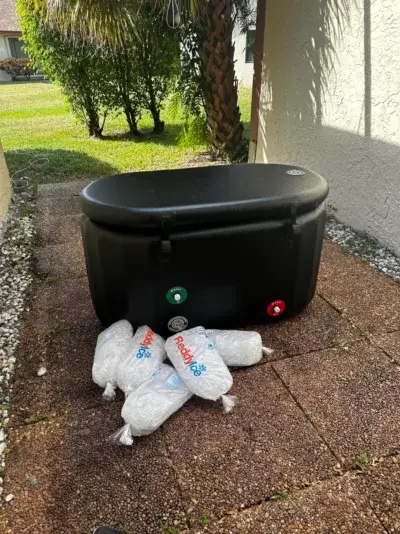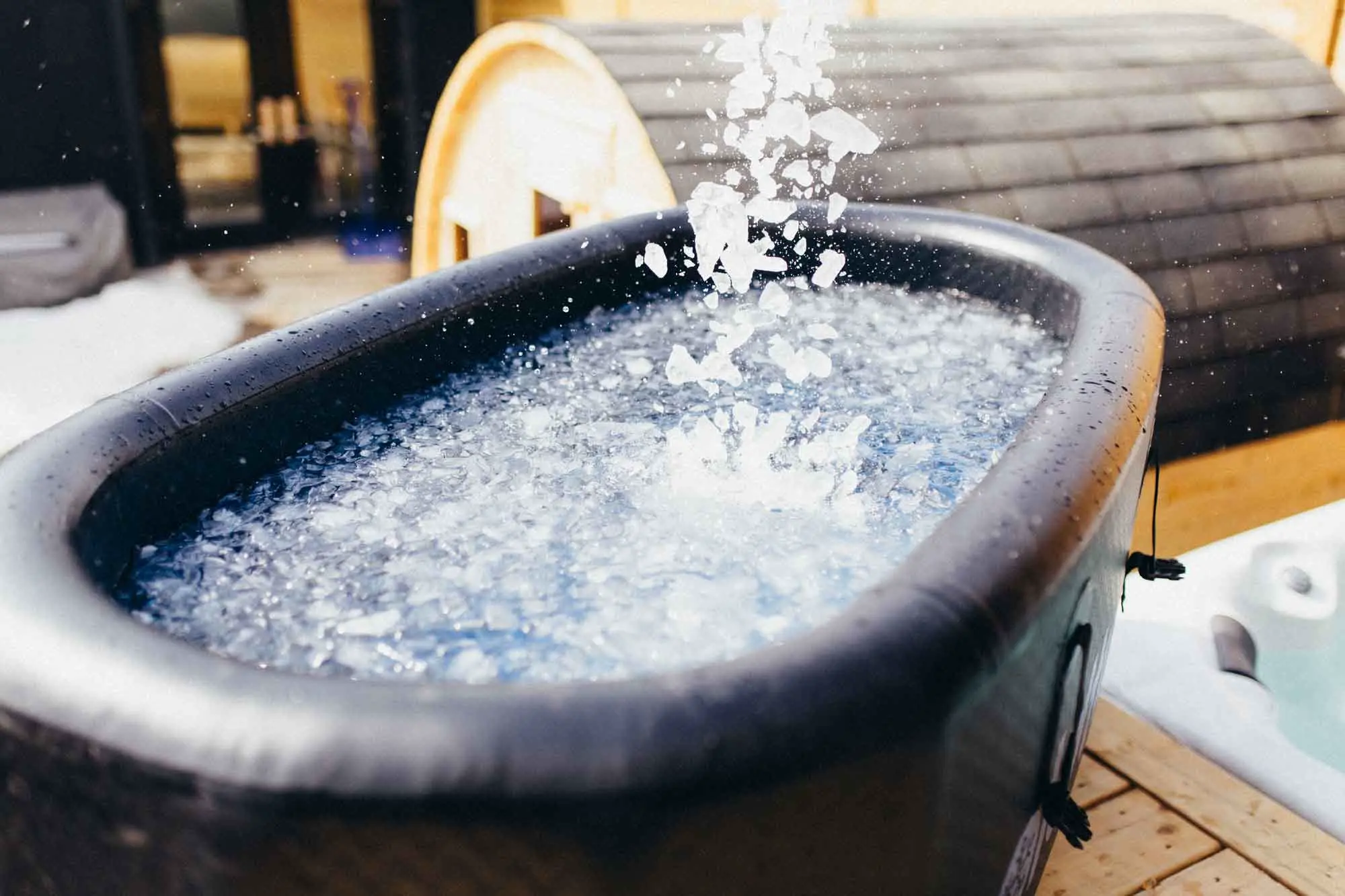Crioterapia vs bagno di ghiaccio: Resa dei conti gelida per il recupero
Crioterapia vs bagno di ghiaccio: Resa dei conti gelida per il recupero
Crioterapia vs. Bagno di ghiaccio: Scontro freddo


- Principi:
- Utilizza temperature estremamente basse, In genere vanno da -110 ° C a -160 ° C.
- Mira a innescare risposte fisiologiche, compresa la vasocostrizione seguita da vasodilatazione.
- Implica l'esposizione al freddo attraverso metodi come Cryo Chambers, pacchetti di ghiaccio, o azoto liquido.
- Effetti nel recupero dello sport:
- Promuove un recupero più rapido migliorando la circolazione sanguigna nelle aree interessate.
- Riduce il dolore muscolare e l'infiammazione attraverso la vasocostrizione.
- Termina temporaneamente intorpidimento nervoso, fornendo sollievo dal dolore.
- Rallenta il metabolismo, Aiutare nel controllare l'infiammazione e la promozione della guarigione.
- Durata: Rapida esposizione, duratura 2-5 minuti.
Bagno di ghiaccio:
- Principi:
- Implica immergere il corpo in acqua fredda, di solito con una temperatura inferiore a 10 ° C.
- Mira a ridurre la temperatura locale, rallentare i processi metabolici e ridurre l'infiammazione.
- Comunemente usato per il recupero post-esercizio dagli atleti.
- Effetti nel recupero dello sport:
- Induce vasocostrizione, Ridurre il flusso sanguigno e limitare l'infiammazione.
- Alleviano il dolore muscolare e il gonfiore.
- Fornisce un effetto intorpidito localizzato, Percezione del dolore diminuente.
- Efficace nel controllo e nella prevenzione del dolore muscolare di insorgenza ritardata (Doms).
- Durata: Immersione più lunga, tipicamente 5-20 minuti.
Valutazione del costo e dell'accessibilità: Crioterapia vs. Bagno di ghiaccio
Crioterapia:
- Costo: Tipicamente varia da $50 A $400 per sessione.
- Accessibilità: Offerto in strutture specializzate o centri benessere.
- Considerazioni: Le offerte di pacchetti potrebbero essere disponibili, Ma rimane un investimento significativo. Le posizioni potrebbero non essere così diffuse o convenienti come le palestre o le spa tradizionali.
Bagno di ghiaccio:
- Costo: Principalmente il prezzo del ghiaccio, O a 1HP Harman n Collettino d'acqua per bagno di ghiaccio ha un prezzo più appropriato – 589Dollaro statunitense.
- Accessibilità: Può essere facilmente creato a casa usando una vasca piena di acqua fredda e ghiaccio.
- Considerazioni: Opzione economica per la terapia di recupero. Fornisce il massimo controllo sull'uso, rendendolo conveniente per l'uso domestico senza programmare gli appuntamenti.
In sintesi, Le sessioni di crioterapia hanno un prezzo notevole e sono in genere offerte in strutture specializzate, impatto sull'accessibilità. Al contrario, I bagni di ghiaccio offrono un'alternativa più economica che può essere facilmente allestita a casa, Fornire maggiore controllo e comodità per le persone che desiderano incorporare la terapia fredda nella loro routine senza significativi investimenti finanziari. La scelta tra i due dipende dalle preferenze individuali, considerazioni di bilancio, e la comodità dell'uso a casa.
Comprensione dei rischi e degli effetti collaterali: Crioterapia vs. Bagno di ghiaccio
Crioterapia:
- Rischio: Il congelamento è un rischio primario, che si verifica con un'esposizione prolungata a temperature al di sotto dello zero.
- Effetti: Potenziale danno alla pelle e ai tessuti sottostanti, portando al dolore, rigonfiamento, e necrosi tissutale.
- Precauzioni: Essenziale per seguire le linee guida per la sicurezza e limitare i tempi di esposizione per ridurre al minimo il rischio di congelamento.
- Effetti collaterali: Possono verificarsi irritazione o ustioni della pelle, manifestando come arrossamento, prurito, o blistering post-sessione.
Bagno di ghiaccio:
- Rischio: L'ipotermia è un rischio comune a causa dell'esposizione prolungata a temperature estremamente fredde.
- Effetti: Il calo della temperatura corporea centrale può portare a sintomi come il brivido, confusione, e potenziale perdita di coscienza.
- Precauzioni: Fondamentale per monitorare il tempo trascorso in acqua fredda ed evitare un immersione prolungata per prevenire l'ipotermia.
- Effetti collaterali: Effetti negativi sulla salute della pelle, compreso il congelamento, caratterizzato da intorpidimento, Sensazioni di formicolio, e scolorimento della pelle.
Conclusione: Adattare la scelta per le tue esigenze uniche

Si consiglia di utilizzare la crioterapia per lesioni acute e il recupero post-esercizio, mentre i bagni di ghiaccio possono essere utili per ridurre il dolore muscolare e migliorare la circolazione. Tuttavia, Le preferenze e la tolleranza individuali dovrebbero essere prese in considerazione anche quando si sceglie tra i due metodi.
Se sei interessato al bagno di ghiaccio puoi contattarci in qualsiasi momento, Possiamo fornire Fai -da -te soluzioni e il refrigeratore d'acqua per bagno di ghiaccio, vasche da bagno di ghiaccio gonfiabile portatili, vasche da bagno in legno in metallo Vuoi soddisfare le tue diverse esigenze.
“Vendere prodotti di alta qualità a profitti ragionevoli e trattare i clienti con pazienza e professionalità!"Questo è ciò di cui siamo tutti! Ci impegniamo ad aiutare i bisognosi con un recupero di esercizi più veloce ed efficiente e siamo sempre felici di sentirti.
Prima della partita
Crioterapia vs bagno di ghiaccio: Resa dei conti gelida per il recupero
Crioterapia vs. Bagno di ghiaccio: Scontro freddo


- Principi:
- Utilizza temperature estremamente basse, In genere vanno da -110 ° C a -160 ° C.
- Mira a innescare risposte fisiologiche, compresa la vasocostrizione seguita da vasodilatazione.
- Implica l'esposizione al freddo attraverso metodi come Cryo Chambers, pacchetti di ghiaccio, o azoto liquido.
- Effetti nel recupero dello sport:
- Promuove un recupero più rapido migliorando la circolazione sanguigna nelle aree interessate.
- Riduce il dolore muscolare e l'infiammazione attraverso la vasocostrizione.
- Termina temporaneamente intorpidimento nervoso, fornendo sollievo dal dolore.
- Rallenta il metabolismo, Aiutare nel controllare l'infiammazione e la promozione della guarigione.
- Durata: Rapida esposizione, duratura 2-5 minuti.
Bagno di ghiaccio:
- Principi:
- Implica immergere il corpo in acqua fredda, di solito con una temperatura inferiore a 10 ° C.
- Mira a ridurre la temperatura locale, rallentare i processi metabolici e ridurre l'infiammazione.
- Comunemente usato per il recupero post-esercizio dagli atleti.
- Effetti nel recupero dello sport:
- Induce vasocostrizione, Ridurre il flusso sanguigno e limitare l'infiammazione.
- Alleviano il dolore muscolare e il gonfiore.
- Fornisce un effetto intorpidito localizzato, Percezione del dolore diminuente.
- Efficace nel controllo e nella prevenzione del dolore muscolare di insorgenza ritardata (Doms).
- Durata: Immersione più lunga, tipicamente 5-20 minuti.
Valutazione del costo e dell'accessibilità: Crioterapia vs. Bagno di ghiaccio
Crioterapia:
- Costo: Tipicamente varia da $50 A $400 per sessione.
- Accessibilità: Offerto in strutture specializzate o centri benessere.
- Considerazioni: Le offerte di pacchetti potrebbero essere disponibili, Ma rimane un investimento significativo. Le posizioni potrebbero non essere così diffuse o convenienti come le palestre o le spa tradizionali.
Bagno di ghiaccio:
- Costo: Principalmente il prezzo del ghiaccio, O a 1HP Harman n Collettino d'acqua per bagno di ghiaccio ha un prezzo più appropriato – 589Dollaro statunitense.
- Accessibilità: Può essere facilmente creato a casa usando una vasca piena di acqua fredda e ghiaccio.
- Considerazioni: Opzione economica per la terapia di recupero. Fornisce il massimo controllo sull'uso, rendendolo conveniente per l'uso domestico senza programmare gli appuntamenti.
In sintesi, Le sessioni di crioterapia hanno un prezzo notevole e sono in genere offerte in strutture specializzate, impatto sull'accessibilità. Al contrario, I bagni di ghiaccio offrono un'alternativa più economica che può essere facilmente allestita a casa, Fornire maggiore controllo e comodità per le persone che desiderano incorporare la terapia fredda nella loro routine senza significativi investimenti finanziari. La scelta tra i due dipende dalle preferenze individuali, considerazioni di bilancio, e la comodità dell'uso a casa.
Comprensione dei rischi e degli effetti collaterali: Crioterapia vs. Bagno di ghiaccio
Crioterapia:
- Rischio: Il congelamento è un rischio primario, che si verifica con un'esposizione prolungata a temperature al di sotto dello zero.
- Effetti: Potenziale danno alla pelle e ai tessuti sottostanti, portando al dolore, rigonfiamento, e necrosi tissutale.
- Precauzioni: Essenziale per seguire le linee guida per la sicurezza e limitare i tempi di esposizione per ridurre al minimo il rischio di congelamento.
- Effetti collaterali: Possono verificarsi irritazione o ustioni della pelle, manifestando come arrossamento, prurito, o blistering post-sessione.
Bagno di ghiaccio:
- Rischio: L'ipotermia è un rischio comune a causa dell'esposizione prolungata a temperature estremamente fredde.
- Effetti: Il calo della temperatura corporea centrale può portare a sintomi come il brivido, confusione, e potenziale perdita di coscienza.
- Precauzioni: Fondamentale per monitorare il tempo trascorso in acqua fredda ed evitare un immersione prolungata per prevenire l'ipotermia.
- Effetti collaterali: Effetti negativi sulla salute della pelle, compreso il congelamento, caratterizzato da intorpidimento, Sensazioni di formicolio, e scolorimento della pelle.
Conclusione: Adattare la scelta per le tue esigenze uniche

Si consiglia di utilizzare la crioterapia per lesioni acute e il recupero post-esercizio, mentre i bagni di ghiaccio possono essere utili per ridurre il dolore muscolare e migliorare la circolazione. Tuttavia, Le preferenze e la tolleranza individuali dovrebbero essere prese in considerazione anche quando si sceglie tra i due metodi.
Se sei interessato al bagno di ghiaccio puoi contattarci in qualsiasi momento, Possiamo fornire Fai -da -te soluzioni e il refrigeratore d'acqua per bagno di ghiaccio, vasche da bagno di ghiaccio gonfiabile portatili, vasche da bagno in legno in metallo Vuoi soddisfare le tue diverse esigenze.
“Vendere prodotti di alta qualità a profitti ragionevoli e trattare i clienti con pazienza e professionalità!"Questo è ciò di cui siamo tutti! Ci impegniamo ad aiutare i bisognosi con un recupero di esercizi più veloce ed efficiente e siamo sempre felici di sentirti.
A proposito di ciò che è autore

Benvenuti nel nostro blog! Il mio nome è Peter e sono l'autore principale di questo blog. Come professionista di recupero sportivo e con profondi interessi e competenze.
Mi impegno a presentare concetti complessi in modo chiaro e conciso, e consentire ai lettori di comprendere meglio e applicare tale conoscenza attraverso una ricerca approfondita e la condivisione dell'esperienza.
Grazie per la lettura e per il tuo supporto! Se hai domande o suggerimenti su uno qualsiasi dei contenuti, Non esitate a contattarmi. Non vedo l'ora di condividere informazioni più interessanti e utili con te e di crescere insieme in questo viaggio di conoscenza!
